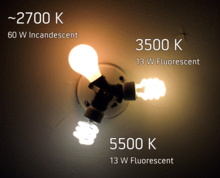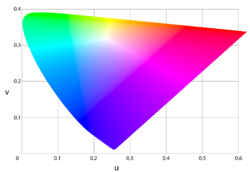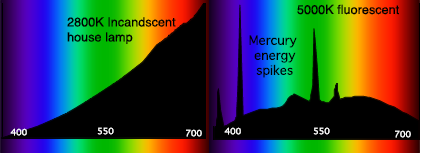Color temperature is a characteristic of visible light that has important applications in lighting, photography, videography, publishing, manufacturing, astrophysics, and other fields. The color temperature of a light source is the temperature of an idealblack-body radiator that radiates light of comparable hue to that of the light source. Color temperature is conventionally stated in the unit of absolute temperature, thekelvin, having the unit symbol K.
Color temperatures over 5,000K are called cool colors (blueish white), while lower color temperatures (2,700–3,000 K) are called warm colors (yellowish white through red).[1]
Contents[hide] |
[edit]Categorizing different lighting
| Temperature | Source |
|---|---|
| 1,700 K | Match flame |
| 1,850 K | Candle flame, sunset/sunrise |
| 2,700–3,300 K | Incandescent light bulb |
| 3,200 K | Studio lamps, photofloods, etc. |
| 3,350 K | Studio "CP" light |
| 4,100 K | Moonlight[2], xenon arc lamp |
| 5,000 K | Horizon daylight |
| 5,500–6,000 K | Vertical daylight, electronic flash |
| 6,500 K | Daylight, overcast |
| 9,300 K | CRT screen |
| These temperatures are merely characteristic; considerable variation may be present. | |
The color temperature of the electromagnetic radiation emitted from an ideal black body is defined as its surface temperature in kelvins, or alternatively in mired (micro-reciprocal Kelvin).[3] This permits the definition of a standard by which light sources are compared.
To the extent that a hot surface emits thermal radiation but is not an ideal black-body radiator, the color temperature of the light is not the actual temperature of the surface. An incandescent light bulb's light is thermal radiation and the bulb approximates an ideal black-body radiator, so its color temperature is essentially the temperature of the filament.
Many other light sources, such as fluorescent lamps, emit light primarily by processes other than thermal radiation. This means the emitted radiation does not follow the form of a black-body spectrum. These sources are assigned what is known as a correlated color temperature (CCT). CCT is the color temperature of a black body radiator which to human color perception most closely matches the light from the lamp. Because such an approximation is not required for incandescent light, the CCT for an incandescent light is simply its unadjusted temperature, derived from the comparison to a black body radiator.
[edit]The Sun
As the Sun crosses the sky, it may appear to be red, orange, yellow or white depending on its position. The changing color of the sun over the course of the day is mainly a result of scattering of light, and is not due to changes in black-body radiation. The blue color of the sky is caused by Rayleigh scattering of the sunlight from the atmosphere, which tends to scatter blue light more than red light.
Daylight has a spectrum similar to that of a black body with a correlated color temperature of 6,500 K (D65 viewing standard) or 5,500 K (daylight-balanced photographic film standard).
For colors based on black body theory, blue occurs at higher temperatures, while red occurs at lower, cooler, temperatures. This is the opposite of the cultural associations attributed to colors, in which "red" is "hot", and "blue" is "cold".[4]
[edit]Color temperature applications
[edit]Lighting
For lighting building interiors, it is often important to take into account the color temperature of illumination. For example, a warmer (i.e., lower color temperature) light is often used in public areas to promote relaxation, while a cooler (higher color temperature) light is used to enhance concentration in offices.[5]
[edit]Aquaculture
In fishkeeping, color temperature has different functions and foci, for different branches.
- In freshwater aquaria, color temperature is generally of concern only for producing a more attractive display. Lights tend to be designed to produce an attractive spectrum, sometimes with secondary attention to keeping plants alive.
- In saltwater/reef aquaria, color temperatures are an essential part of tank health. Cooler temperatures are seen as getting through the water better, providing essential energy sources to the algae hosted in coral, that sustains it. Because coral receives intense, direct tropical sunlight, the focus was once on simulating this with 6,500 K lights. Higher temperature light sources have become more popular as their success became widely known...first 10,000 K, more recently 16,000 K and 20,000 K. Meanwhile, actinic lighting is used to make the somewhat fluorescent colors of many corals and fish "pop", creating brighter "display" tanks.
[edit]Digital photography
In digital photography, color temperature is sometimes used interchangeably with white balance, which allow a remapping of color values to simulate variations in ambient color temperature. Most digital cameras and RAW image software provide presets simulating specific ambient values (e.g., sunny, cloudy, tungsten, etc.) while others allow explicit entry of white balance values in kelvins. These settings vary color values along the blue–yellow axis, while some software includes additional controls (sometimes labeled tint) adding the magenta–green axis, and are to some extent arbitrary and subject to artistic interpretation.[6]
[edit]Photographic film
Photographic emulsion film sometimes appears to exaggerate the color of the light, since it does not adapt to lighting color as human visual perception does. An object that appears to the eye to be white may turn out to look very blue or orange in a photograph. The color balancemay need to be corrected while shooting or while printing to achieve a neutral color print.
Photographic film is made for specific light sources (most commonly daylight film and tungsten film), and used properly, will create a neutral color print. Matching the sensitivity of the film to the color temperature of the light source is one way to balance color. If tungsten film is used indoors with incandescent lamps, the yellowish-orange light of the tungsten incandescent bulbs will appear as white (3,200 K) in the photograph.
Filters on a camera lens, or color gels over the light source(s) may also be used to correct color balance. When shooting with a bluish light (high color temperature) source such as on an overcast day, in the shade, in window light or if using tungsten film with white or blue light, a yellowish-orange filter will correct this. For shooting with daylight film (calibrated to 5,600 K) under warmer (low color temperature) light sources such as sunsets, candlelight or tungsten lighting, a bluish (e.g., #80A) filter may be used.
If there is more than one light source with varied color temperatures, one way to balance the color is to use daylight film and place color-correcting gel filters over each light source.
Photographers sometimes use color temperature meters. Color temperature meters are usually designed to read only two regions along the visible spectrum (red and blue); more expensive ones read three regions (red, green, and blue). However, they are ineffective with sources such as fluorescent or discharge lamps, whose light varies in color and may be harder to correct for. Because it is often greenish, a magenta filter may correct it. More sophisticated colorimetry tools can be used where such meters are lacking.
[edit]Desktop publishing
In the desktop publishing industry, it is important to know a monitor’s color temperature. Color matching software, such as ColorSync will measure a monitor's color temperature and then adjust its settings accordingly. This enables on-screen color to more closely match printed color. Common monitor color temperatures, along with matching standard illuminants in parentheses, are as follows:
- 5,000 K (D50)
- 5,500 K (D55)
- 6,500 K (D65)
- 7,500 K (D75)
- 9,300 K.
Note: D50 is scientific shorthand for a Standard illuminant: the daylight spectrum at a correlated color temperature of 5,000 K. (Similar definition for D55, D65 and D75.) Designations such as D50 are used to help classify color temperatures of light tables and viewing booths. When viewing a color slide at a light table, it is important that the light be balanced properly so that the colors are not shifted towards the red or blue.
Digital cameras, web graphics, DVDs, etc. are normally designed for a 6,500 K color temperature. The sRGB standard commonly used for images on the internet stipulates (among other things) a 6,500 K display whitepoint.
[edit]TV, video, and digital still cameras
The NTSC and PAL TV norms call for a compliant TV screen to display an electrically black and white signal (minimal color saturation) at a color temperature of 6,500 K. On many consumer-grade televisions, there is a very noticeable deviation from this requirement. However, higher-end consumer-grade televisions can have their color temperatures adjusted to 6,500 K by using a preprogrammed setting or a custom calibration. Current versions of ATSC explicitly call for the color temperature data to be included in the data stream, but old versions of ATSC allowed this data to be omitted. In this case, current versions of ATSC cite default colorimetry standards depending on the format. Both of the cited standards specify a 6,500 K color temperature.
Most video and digital still cameras can adjust for color temperature by zooming into a white or neutral colored object and setting the manual "white balance" (telling the camera that "this object is white"); the camera then shows true white as white and adjusts all the other colors accordingly. White-balancing is necessary especially when indoors under fluorescent lighting and when moving the camera from one lighting situation to another. Most cameras also have an automatic white balance function that attempts to determine the color of the light and correct accordingly. While these settings were once unreliable, they are much improved in today's digital cameras, and will produce an accurate white balance in a wide variety of lighting situations.
[edit]Artistic application via control of color temperature
Experimentation with color temperature is obvious in many Stanley Kubrick films; for instance in Eyes Wide Shut the light coming in from a window was almost always conspicuously blue, whereas the light from lamps on end tables was fairly orange. Indoor lights typically give off a yellow hue; fluorescent and natural lighting tends to be more blue.
Video camera operators can white-balance objects which aren't white, downplaying the color of the object used for white-balancing. For instance, they can bring more warmth into a picture by white-balancing off something light blue, such as faded blue denim; in this way white-balancing can serve in place of a filter or lighting gel when those are not available.
Cinematographers do not "white balance" in the same way as video camera operators; they can use techniques such as filters, choice of film stock, pre-flashing, and after shooting, color grading (both by exposure at the labs and also digitally). Cinematographers also work closely with set designers and lighting crews to achieve the desired effects.
For artists, most pigments and papers have a cool or warm cast, as the human eye can detect even a minute amount of saturation. Gray mixed with yellow, orange or red is a "warm gray". Green, blue, or purple, create "cool grays". Note that this sense of temperature is the reverse of that of real temperature; bluer is described as "cooler" even though it corresponds to a higher-temperature blackbody.
 | |
| "Warm" gray | "Cool" gray |
| Mixed with 6% yellow. | Mixed with 6% blue. |
Lighting designers sometimes select filters by color temperature, commonly to match light that is theoretically white. Since fixtures using discharge type lamps produce a light of considerably higher color temperature than tungsten lamps, using the two in conjunction could potentially produce a stark contrast, so sometimes fixtures with HID lamps, commonly producing light of 6,000–7,000 K, are fitted with 3,200 K filters to emulate tungsten light. Fixtures with color mixing features or with multiple colors, (if including 3,200 K) are also capable of producing tungsten like light. Color temperature may also be a factor when selecting lamps, since each is likely to have a different color temperature.[7]
[edit]
The correlated color temperature (Tcp) is the temperature of the Planckian radiator whose perceived colour most closely resembles that of a given stimulus at the same brightness and under specified viewing conditions
[edit]Motivation
Black body radiators are the reference by which the whiteness of light sources is judged. A black body can be described by its color temperature, whose hues are depicted above. By analogy, nearly-Planckian light sources such as certain fluorescent or high-intensity discharge lamps can be judged by their correlated color temperature (CCT); the color temperature of the Planckian radiator that best approximates them. The question is: what is the relationship between the light source's relative spectral power distribution and its correlated color temperature?
[edit]Background
The notion of using Planckian radiators as a yardstick against which to judge other light sources is not a new one.[9] In 1923, writing about "grading of illuminants with reference to quality of color…the temperature of the source as an index of the quality of color", Priest essentially described CCT as we understand it today, going so far as to use the term apparent color temperature, and astutely recognized three cases:[10]
- "Those for which the spectral distribution of energy is identical with that given by the Planckian formula."
- "Those for which the spectral distribution of energy is not identical with that given by the Planckian formula, but still is of such a form that the quality of the color evoked is the same as would be evoked by the energy from a Planckian radiator at the given color temperature."
- "Those for which the spectral distribution of energy is such that the color can be matched only approximately by a stimulus of the Planckian form of spectral distribution."
Several important developments occurred in 1931. In chronological order:
- Davis published a paper on correlated color temperature (his term). Referring to the Planckian locus on the r-g diagram, he defined the CCT as the average of the primary component temperatures (RGB CCTs), using trilinear coordinates.[11]
- The CIE announced the XYZ color space.
- Judd published a paper on the nature of "least perceptible differences" with respect to chromatic stimuli. By empirical means he determined that the difference in sensation, which he termed ΔE for a "discriminatory step between colors…Empfindung" (German for sensation) was proportional to the distance of the colors on the chromaticity diagram. Referring to the (r,g) chromaticity diagram depicted aside, he hypothesized that:[12]
-
- KΔE = |c1 - c2| = max(|r1 - r2|, |g1 - g2|)
These developments paved the way for the development of new chromaticity spaces that are more suited to the estimation of correlated color temperatures and chromaticity differences. Bridging the concepts of color difference and color temperature, Priest made the observation that the eye is sensitive to constant differences in reciprocal temperature:[13]
A difference of one micro-reciprocal-degree (μrd) is fairly representative of the doubtfully perceptible difference under the most favorable conditions of observation.
Priest proposed to use "the scale of temperature as a scale for arranging the chromaticities of the several illuminants in a serial order." Over the next few years, Judd published three more significant papers:
- The first verified the findings of Priest,[10] Davis,[11] and Judd,[12] with a paper on sensitivity to change in color temperature.[14]
The second proposed a new chromaticity space, guided by a principle that has become the holy grail of color spaces: perceptual uniformity (chromaticity distance should be commensurate with perceptual difference). By means of a projective transformation, Judd found a more uniform chromaticity space (UCS) in which to find the CCT. Judd determined the nearest color temperature by simply finding the nearest point on the Planckian locus to the chromaticity of the stimulus onMaxwell's color triangle, depicted aside. The transformation matrix he used to convert X,Y,Z tristimulus values to R,G,B coordinates was:[15]
 .
.From this one can find these chromaticities:[16]

- The third depicted the locus of the isothermal chromaticities on the CIE 1931 x,y chromaticity diagram.[17] Since the isothermal points formed normals on his UCS diagram, transformation back into the xy plane revealed them still to be lines, but no longer perpendicular to the locus.
[edit]Calculation
Judd's idea of determining the nearest point to the Planckian locus on a uniform chromaticity space is current. In 1937, MacAdam suggested a "modified uniform chromaticity scale diagram", based on certain simplifying geometrical considerations:[18]
This (u,v) chromaticity space became the CIE 1960 color space, which is still used to calculate the CCT (even though MacAdam did not devise it with this purpose in mind).[19]Using other chromaticity spaces, such as u'v', leads to non-standard results that may nevertheless be perceptually meaningful.[20]
The distance from the locus (i.e., degree of departure from a black body) is traditionally indicated in units of  ; positive for points above the locus. This concept of distance has evolved to become Delta E, which continues to be used today.
; positive for points above the locus. This concept of distance has evolved to become Delta E, which continues to be used today.
 ; positive for points above the locus. This concept of distance has evolved to become Delta E, which continues to be used today.
; positive for points above the locus. This concept of distance has evolved to become Delta E, which continues to be used today.[edit]Robertson's method
Before the advent of powerful, personal computers, it was common to estimate the correlated color temperature by way of interpolation from look-up tables and charts.[21] The most famous such method is Robertson's,[22] who took advantage of the relatively even spacing of the mired scale (see above) to calculate the CCT Tc using linear interpolation of the isotherm's mired values:[23]

where  and
and  are the color temperatures of the look-up isotherms and i is chosen such that
are the color temperatures of the look-up isotherms and i is chosen such that  . (Furthermore, the test chromaticity lies between the only two adjacent lines for which
. (Furthermore, the test chromaticity lies between the only two adjacent lines for which  .)
.)
 and
and  are the color temperatures of the look-up isotherms and i is chosen such that
are the color temperatures of the look-up isotherms and i is chosen such that  . (Furthermore, the test chromaticity lies between the only two adjacent lines for which
. (Furthermore, the test chromaticity lies between the only two adjacent lines for which  .)
.)If the isotherms are tight enough, one can assume  , leading to
, leading to
 , leading to
, leading to
The distance of the test point to the i'th isotherm is given by

where  is the chromaticity coordinate of the i'th isotherm on the Planckian locus and mi is the isotherm's slope. Since it is perpendicular to the locus, it follows that
is the chromaticity coordinate of the i'th isotherm on the Planckian locus and mi is the isotherm's slope. Since it is perpendicular to the locus, it follows that  where li is the slope of the locus at
where li is the slope of the locus at  .
.
 is the chromaticity coordinate of the i'th isotherm on the Planckian locus and mi is the isotherm's slope. Since it is perpendicular to the locus, it follows that
is the chromaticity coordinate of the i'th isotherm on the Planckian locus and mi is the isotherm's slope. Since it is perpendicular to the locus, it follows that  where li is the slope of the locus at
where li is the slope of the locus at  .
.[edit]Precautions
Although the CCT can be calculated for any chromaticity coordinate, the result is meaningful only if the light sources are nearly white.[24] The CIE recommends that "The concept of correlated color temperature should not be used if the chromaticity of the test source differs more than [ ] from the Planckian radiator."[25] Beyond a certain value of
] from the Planckian radiator."[25] Beyond a certain value of  , a chromaticity co-ordinate may be equidistant to two points on the locus, causing ambiguity in the CCT.
, a chromaticity co-ordinate may be equidistant to two points on the locus, causing ambiguity in the CCT.
 ] from the Planckian radiator."[25] Beyond a certain value of
] from the Planckian radiator."[25] Beyond a certain value of  , a chromaticity co-ordinate may be equidistant to two points on the locus, causing ambiguity in the CCT.
, a chromaticity co-ordinate may be equidistant to two points on the locus, causing ambiguity in the CCT.[edit]Approximation
If a narrow range of color temperatures is considered—those encapsulating daylight being the most practical case—one can approximate the Planckian locus in order to calculate the CCT in terms of chromaticity coordinates. Following Kelly's observation that the isotherms intersect in the purple region near (x=0.325, y=0.154),[21] McCamy proposed this cubic approximation:[26]
- CCT(x, y) = -449n3 + 3525n2 - 6823.3n + 5520.33
where n = (x - xe)/(y - ye) is the inverse slope line and (xe = 0.3320, ye = 0.1858) is the "epicenter"; quite close to the intersection point mentioned by Kelly. The maximum absolute error for color temperatures ranging from 2856 (illuminant A) to 6504 (D65) is under 2 K.
A more recent proposal, using exponential terms, considerably extends the applicable range by adding a second epicenter for high color temperatures:[27]
- CCT(x,y) = A0 + A1exp(-n/t1) + A2exp(-n/t2) + A3exp(-n/t3)
where n is as before and the other constants are defined below:
| 3–50 kK | 50–800 kK | |
|---|---|---|
| xe | 0.3366 | 0.3356 |
| ye | 0.1735 | 0.1691 |
| A0 | -949.86315 | 36284.48953 |
| A1 | 6253.80338 | 0.00228 |
| t1 | 0.92159 | 0.07861 |
| A2 | 28.70599 | 5.4535×10−36 |
| t2 | 0.20039 | 0.01543 |
| A3 | 0.00004 | |
| t3 | 0.07125 |
The inverse calculation, from color temperature to corresponding chromaticity co-ordinates, is discussed in Planckian locus.
[edit]Color rendering index
The CIE color rendering index (CRI) is a method to determine how well a light source's illumination of eight sample patches compares to the illumination provided by a reference source. Cited together, the CRI and CCT give a numerical estimate of what reference (ideal) light source best approximates a particular artificial light, and what the difference is.












 in the CIE 1960 UCS.
in the CIE 1960 UCS.
No comments:
Post a Comment